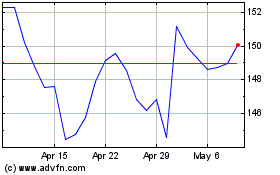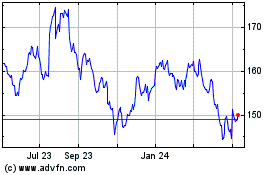Johnson & Johnson to Cut 6% of Medical Device Jobs--4th Update
January 19 2016 - 2:13PM
Dow Jones News
By Jonathan D. Rockoff and Chelsey Dulaney
Johnson & Johnson said Tuesday it would cut about 3,000 jobs
in its medical-devices division, the company's latest step to
revive the struggling business.
The eliminated positions represent 2.5% of the health-care
company's 127,000 employees world-wide and as much as 6% of its
medical-device segment. J&J expects the cuts will save between
$800 million and $1 billion a year before taxes, some of which will
be invested in new-product development.
J&J's medical-device business had been the company's
largest, and its relatively fast-growing sales of artery-opening
stents, knee-replacement parts and other surgical tools once fueled
the company's sales growth while its prescription-drugs and
consumer-health businesses flagged.
But the overall market has slowed because surgeons have lost
much of their buying power as they became salaried employees of
health-care systems and the consolidating hospital systems began
exerting stronger pressure on prices.
The $320 billion market for medical devices world-wide is
growing 4% a year now, down from a double-digit rate in the early
2000s, according to Venkat Rajan, a medical-device industry analyst
at research and consulting firm Frost & Sullivan.
J&J's medical-device sales have slowed even more than the
overall market's the past few years, growing just 1% operationally
in the third quarter, according to Wells Fargo Securities.
In response, J&J has exited from the stents business it had
pioneered and has been selling small, slower-growing units. In
addition, it has been rejiggering how it sells devices and focusing
on high-growth categories like surgical robotics and staplers as
well as key markets such as the U.S., Japan and China.
The company has also struck new partnerships, such as a
collaboration with International Business Machines Corp. to create
virtual coaching services for patients, and another with Google
Inc. to develop surgical tools that take advantage of imaging
technology advances.
In October, J&J said it planned more than 14 product
launches over the next 18 to 24 months. J&J will use some of
the savings from the restructuring to accelerate new-product
development, Gary Pruden, the J&J executive in charge of
medical devices, said in an interview.
The layoffs are "an opportunity to reshape our business to
accelerate growth through meaningful innovation," Mr. Pruden
said.
As part of the restructuring, J&J said it would book $2
billion to $2.4 billion in charges, starting with a restructuring
charge of $600 million in the fourth quarter of 2015.
Excluding those charges and other special items, J&J backed
its 2015 forecasts. The company said it also doesn't expect the
restructuring to affect its plans to buy back $10 billion in stock
or any future acquisitions.
"Be they large or small, we are open to those kinds of
opportunities," Mr. Pruden said.
In addition to its medical device business, J&J also has
been a stronger dollar, patent expirations and increased
competition for many of its prescription drugs, especially its
hepatitis C treatment Olysio.
At midday, shares of J&J had gained 0.6% to $97.55 in
trading on the New York Stock Exchange.
Write to Jonathan D. Rockoff at Jonathan.Rockoff@wsj.com and
Chelsey Dulaney at Chelsey.Dulaney@wsj.com
(END) Dow Jones Newswires
January 19, 2016 13:58 ET (18:58 GMT)
Copyright (c) 2016 Dow Jones & Company, Inc.
Johnson and Johnson (NYSE:JNJ)
Historical Stock Chart
From Aug 2024 to Sep 2024

Johnson and Johnson (NYSE:JNJ)
Historical Stock Chart
From Sep 2023 to Sep 2024
